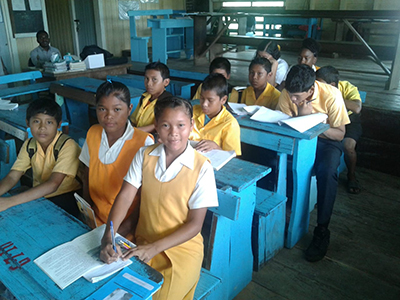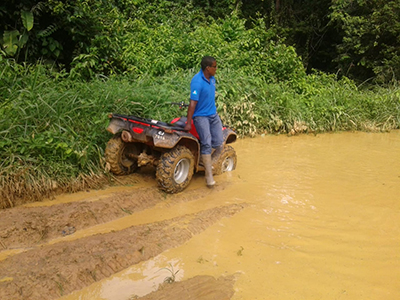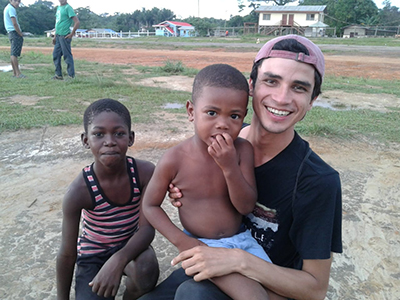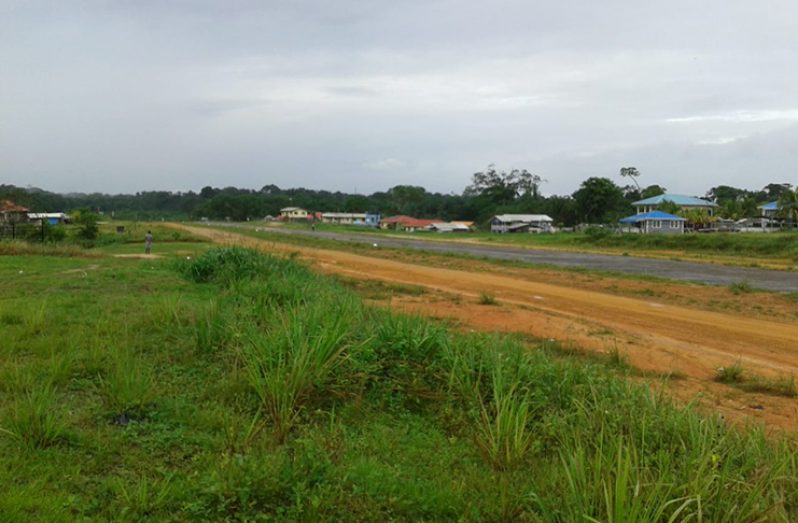By Gibron Rahim
THE community of Baramita is located about 20 miles west of Matthew’s Ridge in Guyana’s Barima-Waini Region. Despite facing numerous challenges, Baramita and its residents are resilient and determined to find solutions to their problems. A recent visitor to the community noted that very fact.

Christian Vargas, a volunteer at Food For The Poor (Guyana) Inc., sat down with the Pepperpot Magazine to talk about his experience during a recent visit to Baramita. He explained that he has a passion for helping families and working with non-governmental organisations (NGOs). He related that he travelled to Baramita with the Food For The Poor (Guyana) Inc.’s project team last week to assess the community’s needs. “This was the main purpose – to identify, in particular, help that the organisation can provide to the village or the community and to identify also the living conditions of the community and some problems that the community is facing now,” Vargas said.
There are two routes to accessing Baramita. The easiest route is by cargo plane. This was the route that Vargas took and he told the Pepperpot Magazine that the view from the airplane is amazing. The other route combines travel over land and water. That route is understandably longer, taking over 20 hours.
STARK DIFFERENCE
Vargas recalled reading up on Baramita before his trip. Most of the news he read was

negative. However, his first impressions of the community contrasted with what he had read. The picture he had been forming in his mind was different from the reality. The landscape of Baramita reminded him of the landscape of southern Chile, his homeland. He explained that the community of Baramita is made up of multiple settlements with some miles of distance between them. Vargas had previously visited the Rupununi and he noted that the styles of traditional Indigenous architecture were different in the two places.
Baramita is actually a community comprising two parts. There is the community surrounding the airstrip and then the various settlements spread throughout the area. Those settlements are made up of Indigenous Peoples of Carib descent. Vargas observed that there is a high male population as well as a high population of children. Mining is the community’s main economic activity. He noted that there are no large mining companies.

Rather, there are small companies and individuals who practice artisanal mining. Residents who work in mining walk miles, up to four hours on a rough road, to reach the mines and then walk the same route to return home at the end of the day. Mainly men are involved in the mining sector but there are also groups of women who often take their children with them. There are even cases where entire families go to the mines.
There are also those who are not native to Baramita but live and work there. These include police officers, teachers, healthcare personnel and those who work in the community’s main shop. However, Vargas pointed out that Baramita is very much a single, unified community.
CHALLENGES
One of the problems facing education in Baramita is the fact that English is not the first language of the community’s children. Carib is the mother tongue that children speak before they enter the school system. However, they are expected to speak English when they begin attending school. The complications related to the language barrier extend to the adults in the community as well. Vargas related that there are instances where persons are given medication and need to have the instructions translated into Carib so that they can take their medicine.
Another problem related to education in the community is the fact that there is no secondary school. While a facility has recently been constructed to serve as a secondary school, there are no teachers available to teach there. Additionally, those who can afford to pursue their secondary education in other communities also do not have the financial resources to continue onto tertiary education. One of the suggestions that the Food For The Poor team offered to Baramita’s Toshao, Sharmain Rambajue was to engage the government on the matter of starting a scholarship programme specific to people from areas like Baramita, allowing them the opportunity to attend university and then return to the community. “And they can speak Carib and English at the same time and understand the problems of their community,” Vargas explained.
Most of the community’s adults do not possess a formal education. “Some parents don’t realise the importance of education of their children,” Vargas said. The Food For The Poor team advised the community to undertake training sessions with the adults in Baramita. Those sessions would teach participants about the importance of education and provide them with skills they can use to better themselves and their community. Vargas underscored the high level of commitment of Baramita’s teachers and those administrating the school and the community.
Alcoholism is one of Baramita’s major problems. High wine was recently banned in the community to attempt to mitigate the issue. Vargas posited that one of the reasons for the problem is that some residents are unemployed. These persons drink to forget the problems they face, including economic problems. This unhealthy way of coping with problems is then passed on to the younger generation. The ban is just one of multiple solutions the leadership of Baramita is considering.
Access to clean water is another issue facing Baramita. Vargas explained that water is available during the rainy season but access becomes a problem during the dry season. Residents mainly drink water from nearby creeks or store water during the rainy season. However, contamination of the water supply is an ongoing problem. Vargas noted that, while there is currently no data on the quality of the water, healthcare personnel at Baramita’s health centre have observed that there are high rates of diarrhoea in the community.
SEEKING SOLUTIONS
In an effort to find solutions to Baramita’s problem, the Toshao has been working with numerous government agencies since her election, including the Ministry of Indigenous Peoples’ Affairs and the Civil Defence Commission. She has also worked with UNICEF on a risk management programme for Baramita. The community’s leadership is also working with NGOs on engaging youths in the community who have completed secondary school, as well as working on providing training to residents in areas such as farming and encouraging them to collaborate on and participate in various community projects.
One of the greatest opportunities for Baramita is in the area of touris, according to Vargas. He explained that showcasing the community’s mining sector can draw in tourists. The Food For The Poor team was able to visit the mines using ATVs (all-terrain vehicles). Vargas pointed out that, as a visitor to Baramita, the experience was amazing. So too was the experience witnessing artisanal mining. Before the community can get involved in the area of tourism; however, programmes regarding sustainable tourism are needed. He affirmed, “I will engage people to fly to Baramita in these cargo planes and maybe visit for a weekend. It could be very interesting for them.”



.jpg)









